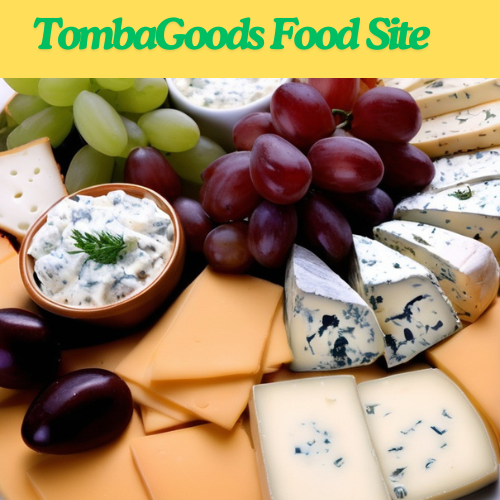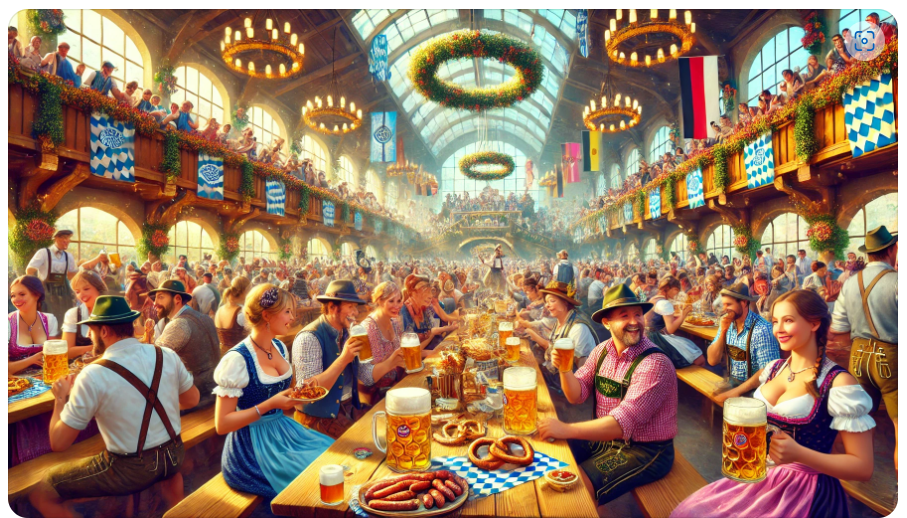
TombaGoods Food Site

Get a Free Download of the 25 Best German Foods
Thank you for your submission!
Your List of the Best German Foods is on its way! Be sure and check your spam folder and whitelist jeff@tombagoods.com so you can receive German Food Recipes and Food Deals from Jeff.
German cuisine is deeply rooted in the nation’s cultural and regional diversity, shaped by centuries of tradition and innovation. It reflects the country’s agricultural history, with hearty and filling dishes that have sustained communities through long winters and bustling harvest seasons. Historically, German food has been influenced by the availability of local ingredients, with each region developing its own specialties based on what was most accessible and abundant.
At the heart of German food is a strong connection to family and communal gatherings. Meals are often seen as a time to come together, whether for a simple supper or a festive celebration. Traditional recipes have been passed down through generations, preserving a rich culinary heritage that blends rustic flavors with refined techniques.
German cuisine has also been shaped by the country’s central location in Europe, with neighboring nations contributing to a dynamic food culture. Over time, Germany's foodways have adapted to global trends, resulting in modern versions of classic dishes that still pay homage to their origins.
Simplicity and comfort are key elements of German cooking, with meals often centered around seasonal produce and straightforward preparation. Whether it’s enjoyed in a countryside inn or a bustling urban biergarten, German food continues to evoke a sense of home, tradition, and pride. The hearty flavors and dedication to craftsmanship in German cuisine offer a glimpse into the country’s soul, where food is not just sustenance, but a celebration of heritage. And, speaking of heritage, during the Oktoberfest German food and beer is celebrated around the world.
German Food Information and List of German Food
This article will give you a lot of information pertaining to German food and also will supply a list of foods that you might want to try. Germany has a rich culinary tradition that varies by region, but several iconic dishes and food categories are known throughout the country. German cuisine is hearty and flavorful, focusing on meats, breads, potatoes, and sausages, but also featuring lighter dishes like salads and seafood. So what are some German foods you ask? Here's an in-depth look at some of the key elements of German foods:
1. Sausages (Wurst)
Germany is world-famous for its variety of sausages, with over 1,500 different types. Here are a few of the most popular kinds:
- Bratwurst: One of the most well-known sausages, bratwurst is made from pork, beef, or veal and is usually grilled or fried. It's often served with mustard and a bun.
- Currywurst: A popular street food, this is a steamed then fried sausage sliced and covered in a curry-flavored ketchup sauce, typically served with fries.
- Weißwurst: A white Bavarian sausage made from veal and pork, traditionally eaten in the morning with sweet mustard and pretzels.
- Blutwurst: A blood sausage, usually made from pork blood, meat, and fat, often flavored with cloves or other spices.
- Leberwurst: A liver sausage spread, often served on bread as a snack or part of breakfast.
2. Bread (Brot)
Germany is known for its extensive bread culture, with over 300 varieties of bread and 1,200 types of rolls and pastries. Some of the most common types are:
- Roggenbrot: Rye bread, typically denser and darker than wheat bread, with a rich flavor.
- Pumpernickel: A dark, coarse, and slightly sweet rye bread that's been baked at a low temperature for a long time.
- Brötchen: Small crusty bread rolls, often served with butter, cold cuts, or cheese for breakfast.
- Brezel: The German pretzel is a soft, chewy bread shaped into a knot, commonly eaten as a snack with mustard or butter.
3. Potatoes (Kartoffeln)
Potatoes are a staple in German cuisine, appearing in many forms:
- Kartoffelsalat: Potato salad, which can vary greatly by region. In southern Germany, it's often made with vinegar and bacon, while in northern Germany, it's typically made with mayonnaise.
- Bratkartoffeln: Pan-fried potatoes, often prepared with onions, bacon, and herbs.
- Kartoffelknödel: Potato dumplings, a common side dish to meat-based meals, made from either raw or cooked potatoes.
4. Meat Dishes
German cuisine includes a variety of meat dishes, with pork being particularly popular:
- Sauerbraten: A pot roast, traditionally made from beef that has been marinated for several days in a mixture of vinegar or wine, water, and spices before being slow-cooked. It is usually served with red cabbage and potato dumplings.
- Schnitzel: A breaded and fried meat cutlet, typically made from pork (Schweineschnitzel) or veal (Wiener Schnitzel), and served with potatoes or a salad.
- Rinderroulade: Beef rolls filled with onions, mustard, pickles, and bacon, slow-cooked in a rich gravy and usually served with mashed potatoes and red cabbage.
5. Dumplings (Knödel)
Dumplings are a popular side dish across Germany:
- Kartoffelknödel: Potato dumplings, often served with roasted meats.
- Semmelknödel: Bread dumplings, made from stale bread rolls mixed with milk, eggs, and herbs. They are popular in Bavaria and often served with gravy.
- Maultaschen: Similar to ravioli, these are large, stuffed pasta pockets filled with a mixture of meat, spinach, and breadcrumbs.
6. Cabbage Dishes
Cabbage is another staple in German cooking, appearing in many traditional dishes:
- Sauerkraut: Fermented cabbage, known for its sour taste, often served as a side dish to sausages and meats.
- Rotkohl/Rotkraut: Red cabbage that is braised with apples, vinegar, and spices, often served with roasted meats.
- Kohlrabi: A mild, slightly sweet cabbage variant that is eaten both raw and cooked.
7. Fish and Seafood
While German cuisine is heavily meat-based, seafood is popular in northern coastal regions:
- Matjes: Young herring, typically served pickled with onions, apples, and sour cream.
- Forelle: Trout, often served pan-fried with butter, almonds, and parsley.
- Rollmops: Pickled herring fillets rolled around pickles and onions, often eaten as a snack or part of a buffet.
8. Cheese (Käse)
Germany produces many types of cheese, especially in the Alpine regions:
- Quark: A fresh, mild cheese, similar to ricotta or cream cheese, used in desserts, spreads, and savory dishes.
- Allgäuer Emmentaler: A hard cheese from the Allgäu region, similar to Swiss Emmental, known for its mild, nutty flavor.
- Harzer Käse: A sour milk cheese that is low in fat and often eaten with onions, vinegar, and oil.
9. Desserts and Pastries
German sweets are diverse, ranging from cakes to cookies and puddings:
- Apfelstrudel: A popular dessert made of thin layers of dough filled with apples, sugar, cinnamon, raisins, and breadcrumbs.
- Schwarzwälder Kirschtorte: Known as Black Forest Cake, this is a chocolate sponge cake layered with whipped cream and cherries, and often flavored with Kirschwasser (cherry schnapps).
- Lebkuchen: A type of gingerbread, traditionally made during Christmas, often spiced with cinnamon, cloves, and nutmeg.
- Stollen: A dense, sweet fruit bread, also associated with Christmas, filled with dried fruits, nuts, and marzipan.
- Bienenstich: A "bee sting" cake made with yeast dough, filled with vanilla custard, and topped with caramelized almonds and honey.
10. Regional Specialties
Germany's regions have their own culinary specialties:
- Bavaria: Famous for pretzels, Weißwurst, and Leberkäse (a meatloaf-like sausage).
- Saxony: Known for Sauerbraten and Quarkkeulchen, a type of sweet potato pancake made with quark.
- Swabia: The home of Spätzle, a type of soft egg noodle, often served with cheese (Käsespätzle) or gravy.
- Berlin: Famous for Currywurst and Berliner Pfannkuchen, a type of filled doughnut.
- Rhineland: Known for Himmel und Erde, a dish of mashed potatoes, apples, and fried black pudding.
11. Beer (Bier)
Beer is deeply ingrained in German culture, and the country is known for its wide variety of brews. Some famous types include:
- Pilsner: A light, golden beer that is crisp and slightly bitter, popular throughout Germany.
- Weißbier: A wheat beer, particularly popular in Bavaria, known for its fruity and slightly spicy flavors.
- Dunkel: A dark, malty beer, common in Bavaria.
- Bock: A strong, dark beer often brewed for the winter months or festivals like Easter and Christmas.
12. Wine (Wein)
Germany is also known for its wine, especially Riesling, a white grape variety that produces aromatic, often slightly sweet wines. The main wine-producing regions are:
- Rheinhessen
- Mosel
- Pfalz
- Baden
13. Festive Foods
Certain foods are closely tied to German holidays and festivals:
- Oktoberfest: Bavarian festival foods include pretzels, roast chicken (Hendl), pork knuckles (Schweinshaxe), and beer. Read Oktoberfest article below.
- Christmas Markets: Foods like roasted chestnuts, Glühwein (mulled wine), Bratwurst, and Stollen are popular at Germany’s festive markets.
German food is deeply connected to regional traditions and family recipes, offering a rich tapestry of flavors and dishes that are both hearty and satisfying. From sausages to sweets, bread to beer, Germany’s culinary legacy is a delicious reflection of its diverse culture and history.

Oktoberfest: A Celebration of Bavarian Tradition
Oktoberfest, the world’s largest beer festival, takes place every year in Munich, Germany, attracting millions of visitors from around the globe. This festival is a showcase of Bavarian culture, where traditions, food, and, of course, beer take center stage. Whether you’ve experienced it firsthand or only seen pictures of people in lederhosen and dirndls hoisting giant steins of beer, Oktoberfest is a cultural celebration unlike any other. Here’s a detailed look into the history, atmosphere, traditional foods, and other unique elements of this cherished event.
The Origins of Oktoberfest
The origins of Oktoberfest can be traced back over 200 years to the wedding celebration of Crown Prince Ludwig (later King Ludwig I) and Princess Therese of Saxony-Hildburghausen on October 12, 1810. The citizens of Munich were invited to join in the festivities, which included a horse race, and the celebration was such a success that it became an annual event. Over time, the horse race was replaced by beer drinking and other festivities, and Oktoberfest as we know it today was born.
Oktoberfest traditionally starts in mid-September and runs for 16 to 18 days, ending on the first Sunday in October. The festival is held in the Theresienwiese (often referred to simply as the "Wiesn"), a large open area in the heart of Munich that covers approximately 100 acres. While the festival has grown and evolved, it remains firmly rooted in Bavarian culture, with its beer, food, music, and traditional clothing reflecting this rich heritage.
The Oktoberfest Atmosphere
As you step into the sprawling festival grounds, you're immediately greeted by the sight of enormous beer tents, each capable of seating thousands of revelers. There are 14 major beer tents at Oktoberfest, each run by a different brewery or host and offering its own unique atmosphere. The largest, the Hofbräu-Festzelt, can seat up to 10,000 people and is famed for its raucous and lively atmosphere.
Decorated with vibrant banners, flags, and garlands, the beer tents become the epicenter of Oktoberfest activities. Long wooden tables stretch through the vast halls, with groups of friends, families, and travelers from across the world laughing, singing, and drinking. Live brass bands play traditional Bavarian folk music, such as the famous "Ein Prosit," a song played every 20 minutes that encourages everyone to take a sip of their beer and toast to good health.
Outside the tents, the fairground is packed with amusement rides, carnival games, souvenir stalls, and food vendors, offering a truly festive atmosphere. The smell of grilled sausages, roasted chicken, and sweet treats fills the air, and there’s a palpable sense of joy and celebration as people wander the grounds, enjoying the many sights and sounds of Oktoberfest.
Traditional Oktoberfest Foods
While beer is undoubtedly the star of Oktoberfest, the food plays an equally important role in the celebration. The festival features a wide array of traditional Bavarian dishes that perfectly complement the hearty brews served in the beer tents. Here are some of the classic foods you can expect to find at Oktoberfest:
1. Bratwurst
One of the most iconic German sausages, bratwurst is a must-try at Oktoberfest. These pork sausages are typically grilled and served with mustard on a roll or alongside sauerkraut.
2. Weißwurst
Weißwurst, or "white sausage," is a traditional Bavarian sausage made from minced veal and pork back bacon. It’s usually flavored with parsley, lemon, mace, onions, and ginger. Weißwurst is served in a bowl of hot water with a side of pretzels and sweet mustard. Since it’s made without preservatives, this sausage is traditionally eaten before noon.
3. Brez’n (Pretzels)
Soft, chewy pretzels are an Oktoberfest staple. These large, golden-brown knots of dough are sprinkled with coarse salt and are often served with mustard or alongside beer for a satisfying snack.
4. Schweinebraten (Roast Pork)
Schweinebraten, or roast pork, is a savory dish typically served with a side of rich gravy, potato dumplings (knödel), and red cabbage. It’s a hearty meal that pairs perfectly with a cold beer.
5. Hendl (Roast Chicken)
Another Oktoberfest favorite, hendl is a simple yet delicious dish of roast chicken seasoned with herbs and spices. It’s often served whole or halved, with crispy skin and tender meat that’s perfect for tearing apart with your hands.
6. Knödel (Dumplings)
Knödel are large, round potato or bread dumplings served as a side dish with meat or gravy. They are particularly popular when paired with dishes like Schweinebraten or sauerbraten (pot roast).
7. Sauerkraut and Rotkohl (Red Cabbage)
These traditional German side dishes are often served alongside meat dishes. Sauerkraut is fermented cabbage with a tangy flavor, while rotkohl is a sweet-and-sour braised red cabbage. Both provide a refreshing balance to the rich, meaty dishes of Oktoberfest.
8. Käsespätzle
A Bavarian version of mac and cheese, käsespätzle consists of soft egg noodles layered with melted cheese and topped with crispy fried onions. It’s comfort food at its finest.
9. Reiberdatschi (Potato Pancakes)
Also known as Kartoffelpuffer, these crispy potato pancakes are fried to perfection and often served with applesauce or sour cream. They make for a great snack or side dish during the festivities.
10. Lebkuchenherzen (Gingerbread Hearts)
These decorative gingerbread cookies are often iced with sweet messages like “Ich liebe dich” (I love you) or “Oktoberfest 2024” and hung around the neck with ribbons. They’re a fun souvenir to take home, though they can also be eaten!
Beer at Oktoberfest
Of course, no Oktoberfest would be complete without the beer. Only beer brewed within the city limits of Munich and conforming to the Reinheitsgebot (the German Beer Purity Law of 1516) is allowed to be served at the festival. This means the six main Munich breweries—Augustiner, Hacker-Pschorr, Hofbräu, Löwenbräu, Paulaner, and Spaten—are the exclusive suppliers of beer to Oktoberfest.
The beer served is a special variety known as **Märzen**, a slightly stronger, darker beer brewed in March and left to mature throughout the summer. It has a higher alcohol content (around 5.8% to 6.3% ABV) than regular beer and a rich, malty flavor that pairs perfectly with the hearty foods of Oktoberfest.
Each beer tent serves its own unique beer brewed by one of the six Munich breweries. The beer is served in one-liter steins known as **Maßkrüge**, and it’s not uncommon to see festival-goers stacking several empty steins on top of each other as they make their way back to the bar for another round.
Bavarian Dress: Dirndls and Lederhosen
One of the most charming aspects of Oktoberfest is the traditional clothing worn by festival-goers. Bavarian men don lederhosen, which are knee-length leather pants held up by suspenders, often paired with checkered shirts and woolen socks. Women wear dirndls, traditional dresses consisting of a blouse, bodice, and full skirt, often tied with an apron. Wearing traditional Bavarian attire is a fun way for both locals and visitors to immerse themselves in the spirit of the festival.

Beyond Munich: Oktoberfest Around the World
While Munich’s Oktoberfest is the most famous, similar festivals are held around the world, from Brazil to the United States, each putting its own local spin on the event. In cities like Cincinnati, Ohio, and Kitchener-Waterloo in Canada, these celebrations attract thousands of people every year who gather to enjoy Bavarian food, beer, and music in honor of Munich’s great tradition.
Conclusion
Oktoberfest is more than just a beer festival—it's a joyous celebration of Bavarian culture, a gathering of friends and strangers, and an experience that brings people together from all over the world. Whether you’re indulging in bratwurst, singing along to Ein Prosit or soaking in the vibrant atmosphere of a beer tent, the magic of Oktoberfest is truly unforgettable.
If you would like German food delivered right to your doorstep, CLICK HERE.
